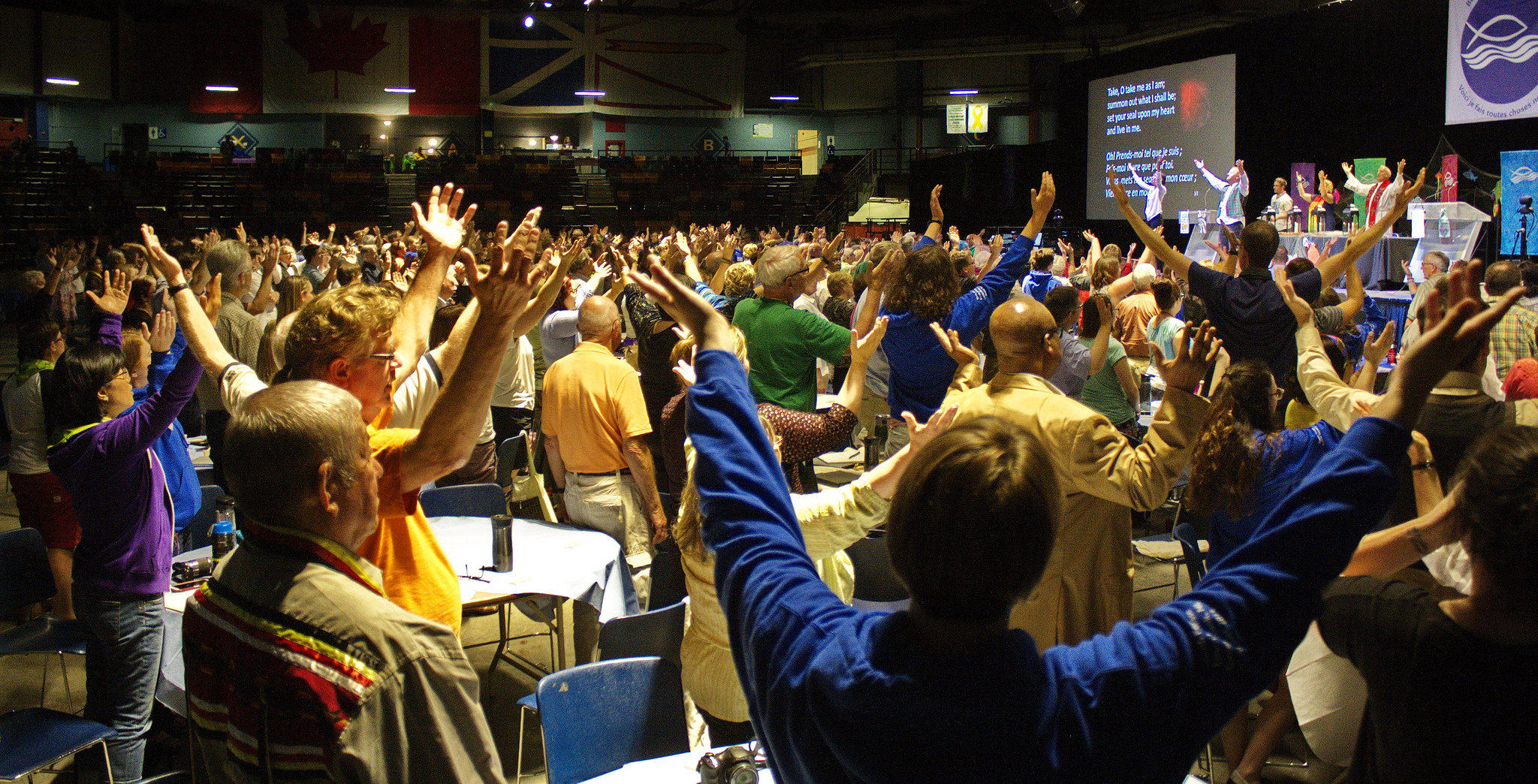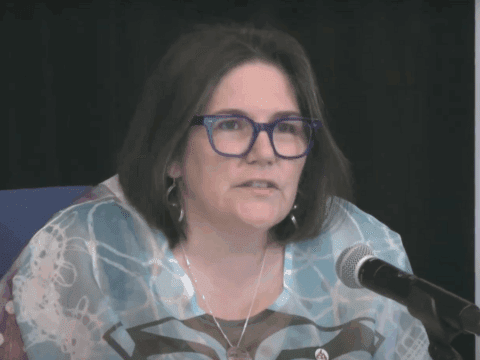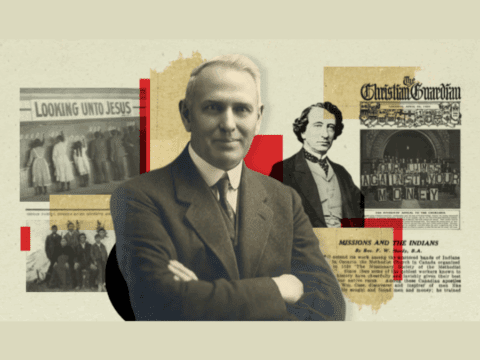Welcome to the last meeting of the General Council. After 93 years as the top governing body of The United Church of Canada, the weeklong gathering will almost certainly be replaced by a smaller denominational council.
This year’s meeting will differ from previous versions in many ways. Downloadable workbooks will replace paper-packed binders; balloting will be done by electronic “clickers”; advance information-sharing webinars will replace report presentations; priorities will be set by commissioners, not the business committee; and a new business process is in place to increase discussion and speed decision-making. The gathering will also happen in July instead of the usual August.
Co-hosted by Bay of Quinte and All Native Circle Conferences, the 43rd General Council will be held on the accessible and nearly new campus of the University of Ontario Institute of Technology in Oshawa, Ont., from July 21 to 27. The event kicks off with its greatest innovation, a Festival of Faith. The two-day festival overlaps with six days of formal meetings. It includes musicians, buskers, spoken-word artists, an Indigenous teaching lodge, and spiritual and social justice workshops, plus other activities and programs for children, youth and adults. Some festival events also spread onto the neighbouring campus of Durham College.
Formal meeting sessions, which begin as the festival continues for a second day, are expected to put the final stamp of approval on a new organizational and governance structure for the United Church. The plan was adopted at the last General Council meeting in Corner Brook, N.L., three years ago, then confirmed by church-wide votes last summer. The 356 commissioners at next month’s meeting will also deal with proposals from Presbyteries, Conferences and General Council units, including one aimed at renewing relationships with the church’s Indigenous ministries.
What should emerge is a governance structure more suited to the United Church’s second century than its first, a more equitable relationship with Indigenous ministries and perhaps proof, amid the serious business, that church folks also know how to have fun.
The checks and balances built into the United Church’s constitution in 1925 require that remit results be received and confirmed before General Council can officially put major changes into effect. Strong voter turnout and widespread support for those church-wide proposals suggest that approval of the new structure at this summer’s Council meeting is a sure thing. Rev. Larry Doyle, chair of planning for the meeting and minister at Courtice United near Oshawa, says “it’s not like there will be a ton of debate” over restructuring, even though it’s one of the most important matters on the agenda.
What will emerge is a church with three decision-making councils — at denominational, regional and community-of-faith levels — replacing the current four courts of General Council, Conferences, Presbyteries and pastoral charges. Oversight and support on ministry personnel matters, formerly handled for the most part by Presbyteries and Conferences, will be managed by a Toronto-based Office of Vocation.
Instead of being funded through voluntary Mission & Service donations, governance and administration will be financed by assessments paid by all communities of faith, based on an income-linked formula. Mission & Service will then fund only mission-related endeavours, with about 10 percent of givings going to Embracing the Spirit, General Council’s “learning network and innovation fund,” meant to help communities of faith adapt, change and thrive.
Once approved by General Council, changes to the church’s constitution, the Basis of Union, still have to be enshrined in federal government amendments to The United Church of Canada Act from 1924. That should take place next year.
General Council’s top administrator, general secretary Nora Sanders, says she hopes “the structural changes that have occupied so much time and energy will be enacted” and that the church can “move on into living them out, and to refocus on how we live out our role as people of faith in Canada and the world, following the example and teachings of Jesus.”
Sanders is careful to note that because the final decision about enacting the remit results is not made until General Council, “we have had to respect that all planning is at this time provisional.” At the same time, she adds, “we have needed to prepare to meet the expectations of the church that all will be ready for the changes to be put into effect.”
General Council staff and volunteers have been busy laying the groundwork. Regions, which will form the middle councils of the church, have been set at 16 and sorted into six geographical groupings that will share staff. Six of the 13 current Conference executive secretaries were named as executive ministers on a provisional basis. Conferences, Presbyteries and the Aboriginal Ministries Council have been asked to nominate people to serve on transition commissions for each region, to be appointed by General Council to help lead the regions until they elect their own councils.
The current Executive and sub-Executive of the General Council will stay in place until the end of this year, when a denominational council Executive (about one-third the size) takes over. The full denominational council will have 260 members, 96 fewer than the current General Council.
Other elements of the transition are also being worked out. The Table de concertation des Ministères en français, regions and the general secretary will work together to support ministries in French. A September video-conference meeting of the Executive will decide on a new version of the Manual. A volunteer 15-member board of vocation will be named to oversee the work of the new Office of Vocation, which will handle the candidacy, training, oversight and discipline of ministers. Finally, a consultation with church-related financial corporations, extension councils, Presbyteries and Conferences with more than $250,000 in assets is planned for this month, to consider how that money could be used.
If the widely supported structural, ministry personnel and funding decisions are sure to be confirmed, what will General Council do with the rest of its time?
For starters, commissioners will discuss and consider a wide-ranging report from the Caretakers of Our Indigenous Circle, a group of Indigenous ministry volunteers and staff from across the church’s Indigenous Conferences, Presbyteries, councils and other groups. Titled Calls to the Church, it points the church toward a new way of relating to its Indigenous communities of faith.
Providing a “framework for reconciliation,” the report puts the relationship between the church and its Indigenous ministries into the context of their own history and the United Nations Declaration on the Rights of Indigenous Peoples. “We will maintain right relations with the broader United Church and educate them about our need to Indigenize our work and decolonize what continues to harm us,” the document states. Indigenous ministries “will decide for ourselves who we are,” which includes determining training programs for Indigenous ministers and an “Indigenous understanding of the Christ story.” An Indigenous department should be part of the new Office of Vocation, with increased support for Indigenous student ministers and a unique church-certified training program.
Calls to the Church also asks that Indigenous communities of faith and urban ministries be able to choose “dual belonging” to both a regional body and a national Indigenous group. In recent decades, most United Church Indigenous congregations have been part of the five Presbyteries that make up the All Native Circle Conference, while a minority remained in non-Indigenous Presbyteries and Conferences. The report calls for a national Indigenous Elders’ council and a national Indigenous organization to be established, complete with a support staff team.
Further, the Caretakers call on the national United Church “to incorporate Indigenous community of faith input into all its programs, departments, divisions and works.” The denomination is “rich in land and properties” that were “stolen by false promises in treaty negotiations,” and at least some of the proceeds from sales of decommissioned church properties should be given back to Indigenous ministries.
Cheryl Jourdain, speaker of the All Native Circle Conference, hopes that advance webinars and workshops will help commissioners understand and accept the Calls to the Church report and “create some momentum . . . because it’s exhausting to have to keep reminding the church. Sometimes it feels like being a watchdog, but that’s not the relationship we want.”
Plenty more items will fill up Council’s decision-making agenda, but those issues — like the identity of half of the commissioners — hadn’t been decided by press time.
While planning chair Doyle does not foresee any “hot-button issues” emerging, he says Council “always has more proposals than we can manage, or manage well.”
Once proposals are received from Conferences by mid-June, Council organizers will corral them all into thematic groups and use an email poll of commissioners to set the top 10 priorities.
Then, Council’s new business process will kick in. Mandated in the wake of the last General Council, it draws on procedures used by several other global church organizations and denominations. After receiving information about an issue (preferably through a pre-meeting webinar), commissioners discuss the matter in small groups. Recorders take notes that are shared with all groups. Then a facilitation group crafts the wording of a proposal that reflects the discussion and the concerns that emerged.
“It’s one method of going for a consensus and trying to hear that greater wisdom,” says Allan Buckingham, Council business committee chair. The goal is to phrase proposals “in a way that the majority of people can agree to move forward on.” If new concerns emerge, changes can be made quickly or the proposal goes back to the facilitation group and is presented again later.
Based on the principle of having better conversations about important things, the process has been test driven at two meetings of the General Council Executive. It seems to promote more widespread input from voting members and keep business moving smoothly and quickly.
Along with the university campus’s well-wired and brightly lit meeting rooms, General Council commissioners will enjoy home-baked snacks from a local Presbytery, and hundreds of volunteers will be on hand to help.
On the free afternoon Wednesday, commissioners can head west to Toronto and a Blue Jays baseball game, or east to Petroglyphs Provincial Park, the Curve Lake First Nation, Sandbanks Provincial Park, Peterborough’s Canadian Canoe Museum, the Lang Pioneer Village, a lavender farm or a dinner cruise through the Trent-Severn Waterway’s famed lift lock.
“We’re just excited about hosting,” says Rev. Cathy Gradante, local arrangements chair and minister in nearby Fraserville, Ont.
Because the Oshawa General Council is a historic turning point for the church, evenings are set aside for ceremonies, including gatherings hosted by Indigenous and LGBTQ groups. A Celtic-style gathering will mark the end of Conferences, and the youth at Council will host an evening on the church’s apologies.
And since the position of moderator remains relatively unchanged after restructuring, commissioners will elect a new one, to be installed before the meeting wraps up with closing worship Friday evening.
Editor’s note: This story first appeared in the June 2018 issue of The Observer with an incorrect report that Buffy Sainte-Marie would be performing at the Festival of Faith. We regret the error.















